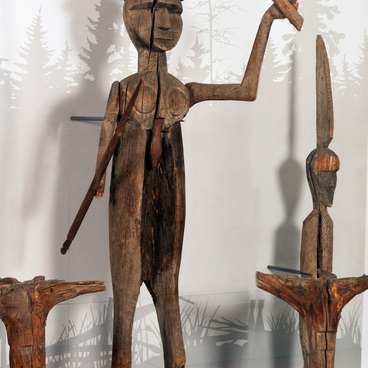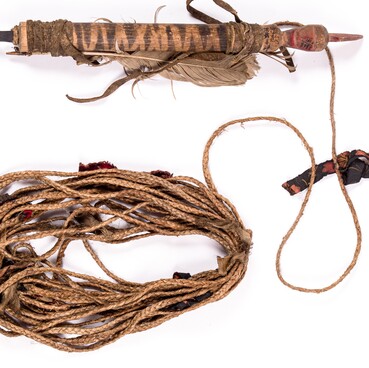The shaman’s headdress was considered a symbol of power. Only the strongest shaman, the so-called “kasaty”, could be the owner of a hat with long fur strips. His functions included carrying the souls of dead people to the afterlife of the Lower World. Indigenous peoples believed that this ritual was difficult, dangerous and long. Not everyone could perform such rituals.
There were not many powerful shamans among the Ulchi and Nanai people. In case the Ulchi lacked a kasaty-shaman, they could turn to the Nanai for help. These two peoples shared the design of such hats.
The base of a kasaty-shaman’s hat was a metal hoop. Narrow metal strips were attached to it and crossed at the top of the hat. Strips of fur were overlaid on the metal. They were fixed so that they descended from the head to the waist. Thanks to these fur strips, the hat became larger. The strips could cover the face.
The fur of only certain animals was used: wolf, bear, raccoon, fox, badger or lynx. The point is that these animals were considered patrons and helpers of the shaman. The skins of small fur-bearing animals, as well as tigers and otters, could not be used. It was explained by the fact that the latter could turn into devils and evil spirits.
Narrow strips of red and blue cloth were usually sewn between strips of fur. Metal horns were attached to the top of the hat; it was considered impossible to perform the ritual without them. An iron gasa duck with a long tail was placed between the horns. A copper circle was attached to the forehead, to illuminate the way in the underworld.
The peoples believed that the horns of the hat became the dwelling place of savans (spirits) of different clans, and the central bells housed the ayami patron spirit. The other bells symbolized the shaman’s dogs.
According to the
eyewitnesses, it was difficult for the shaman to take off the hat after the
ritual, and sometimes it was torn off with the hair. It seemed to grow on the
head, and the shaman would forcefully knock it off with his staff. While the
shaman was wearing it, he was a servant of his patron spirits and protectors,
as well as a terrible enemy of their opponents. The peoples believed that this was
the reason why the spirits were so persistent in not allowing him to take off
his hat.


